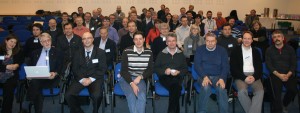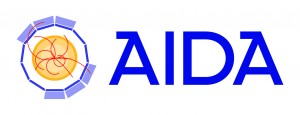When a project has the musical name AIDA but is all about organising the future of detector technologies for particle physics, metaphors from the world of opera only go a certain way. It is therefore understandable, if a bit of a pity, that the 80 European institutes involved in the project decided to gather for their kick-off meeting (rather than the premiere) and refer to their host Laurent Serin as Scientific Coordinator rather than as conductor. They met at CERN in February and will be working on advanced European infrastructures for detectors at accelerators (thus the name AIDA) for the next four years with a budget of 26 million Euros, eight of which will be from the EU under the Seventh Framework programme.
The kick-off meeting marks the official beginning of the project that focuses on European infrastructures, networking activities and joint research projects for detector development – specifically for detector technologies for future particle accelerators like the linear collider, the upgrade of the LHC, Super-B factories or neutrino experiments. Conductor-coordinator Laurent Serin was happy about the 125 registrants at the meeting: “It is great to see people coming together, in some cases for the first time, ready and enthusiastic to collaborate and advance detector development,” he said.
If the detectors and their developers are the actors, the infrastructures are the stage set that puts them in context and breathes scientific life into them – test beams, beam telescopes, labs and all those other facilities that every lab and institute would like to have but cannot necessarily afford.
A special AIDA leitmotif is the promotion of transnational access, which means that researchers can apply for travel grants, free use of facilities and in some cases even a daily allowance to test their systems in the AIDA facilities. Test beams at CERN and DESY and irradiation facilities at CERN, in Belgium, Slovenia and Germany are on the menu.
Many talks during the kick-off meeting made it clear that AIDA is like an enhanced encore to the EUDET project that ended last year. Many successful projects continue during the four years of AIDA, including for example the development of a prototype for an ILC time projection chamber (TPC). The magnetic field needed to test the TPC and its readout modules under (almost) real-life conditions had been shipped from Japan to DESY under EUDET. Under AIDA it will travel back to Japan for an upgrade that will make its cooling system easier to handle: as a magnet designed for a balloon-borne experiment it featured a helium system that was self-sustained but also complicated and work-intensive. It will now be fitted into a cryomodule that will ensure safe, easy and efficient operation for the many future user groups, and after six months of modification and shipping around the world it is supposed to be back in the test beam at the beginning of 2012.
AIDA also tackles an area that fits snugly into one of the most important challenges for the linear collider – industrialisation of mass-produced components. Detector developers work together with industry to find the best existing technologies, create new ones and search for the best way to produce them. First steps were taken live during the kick-off meeting because an industrial event on silicon photomultipliers took place at CERN at the very same time.
ILC NewsLine will follow the AIDA project and its highlights and results in future issues. The curtain has only just been raised…
Read more about the project in ILC NewsLine:



Recent Comments